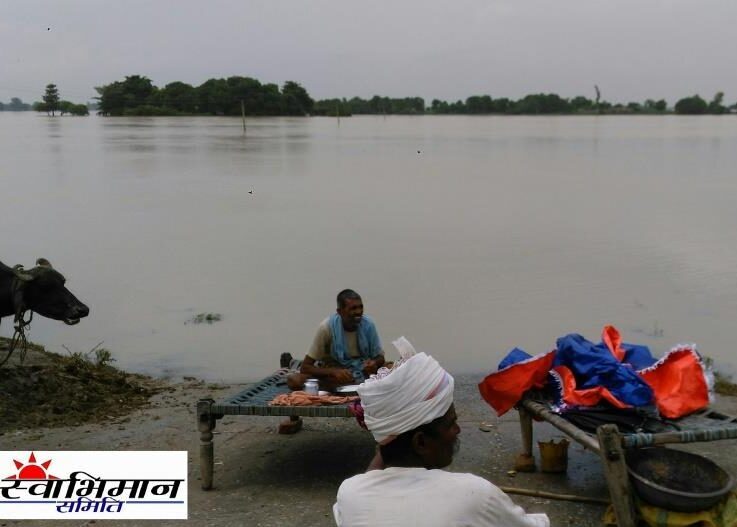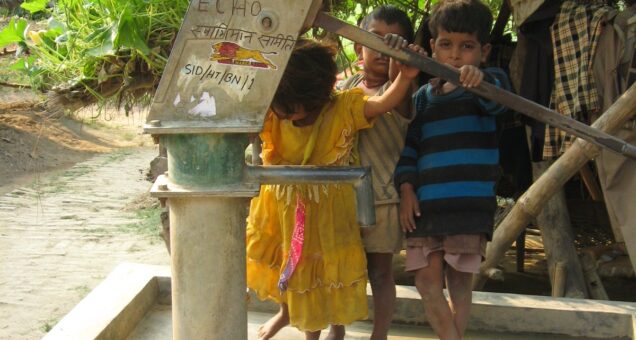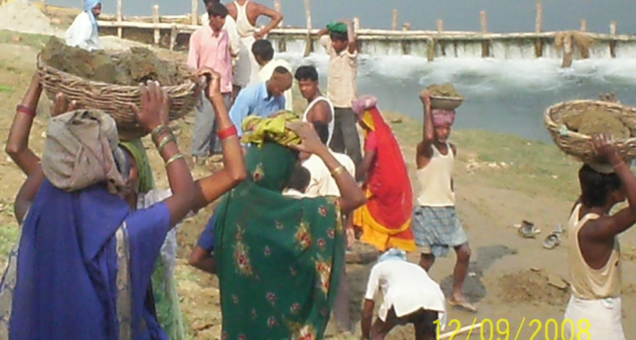Flood Relief and Rehabilitation Programme
The Flood Relief and Rehabilitation Programme (2007-08), implemented by Swabhiman Samiti with support from European Commission Humanitarian Aid and guidance from Action Aid India, was designed to provide immediate relief and long-term recovery for flood-affected communities in Siddharthnagar District, Uttar Pradesh. The program focused on delivering essential aid, restoring livelihoods, improving water access and sanitation, and building disaster preparedness to help the community recover and become more resilient to future floods.
Key Highlights:
- Relief Distribution: Provided essential relief kits including food and household items to 1200 families.
- Shelter Construction: 78 improved houses were built for flood-affected families.
- Livelihood Support: 150 families received agricultural tools, seeds, and livelihood restoration packages.
- Water Restoration: 20 hand pumps were restored to provide safe drinking water to 900 people.
- Community Preparedness: Trained 8 volunteer committees for future disaster response.
SS










Project Details
- Project Name:
- Flood Relief and Rehabilitation Programme
- Thematic Area:
- Livelihood
- Outcome:
- All 1200 familiesreceived essential relief materials, addressing immediate needs.
Funded By
- Funder Name:
- European Commission Humanitarian Aid & Action Aid India
- Implementing Body:
- Swabhiman Samiti
Implemented By
Work Place
- Place of Work:
- Siddharthnagar District, Uttar Pradesh, India
- Year:
- 2007-08
1. Project Overview
The Flood Relief and Rehabilitation Programme (2007-08) was implemented by Swabhiman Samiti, with support from the European Commission Humanitarian Aid and under the guidance of Action Aid India. The program aimed to provide both immediate relief and long-term rehabilitation to flood-affected communities in Siddharthnagar District, Uttar Pradesh. The program reached 1200 families across 5 Gram Panchayats, focusing on restoring livelihoods, improving water and sanitation conditions, and building community resilience against future disasters.
2. Objectives
The primary objectives of the program were:
- Immediate Relief: Provide essential relief materials to flood-affected families.
- Livelihood Restoration: Support the most vulnerable households in regaining their livelihoods.
- Improved Shelter: Construct safer homes for affected families to withstand future floods.
- Water and Sanitation: Restore water sources and improve sanitation facilities to reduce health risks.
- Health Support: Control and prevent the spread of diseases, including malaria.
- Disaster Preparedness: Build capacity for future disaster response through community volunteer committees.
3. Background and Rationale
Siddharthnagar District in Uttar Pradesh faced severe flooding in 2007, which disrupted the lives of thousands of people. The floodwaters damaged homes, crops, and infrastructure, leaving many families without basic necessities. The region's vulnerability was exacerbated by inadequate disaster preparedness, poor sanitation, and limited access to healthcare. The Flood Relief and Rehabilitation Programme was launched to address these urgent needs and to lay the foundation for long-term recovery and resilience. The program sought to restore livelihoods, improve living conditions, and ensure the community was better equipped for future flood events.
4. Planned Outreach
- Geographical Location: Siddharthnagar District, Uttar Pradesh.
- Covered Gram Panchayats: 5 Gram Panchayats across flood-affected areas.
- Beneficiaries: 1200 families (approximately 6000 individuals).
- Program Duration: 2007-08.
5. Key Strategies
- Community-based Relief Distribution: Prioritize the distribution of essential relief materials to flood-affected families, ensuring food security and immediate survival.
- Vulnerability Identification: Use a participatory vulnerability assessment (PVA) to identify the most affected and vulnerable families for targeted support.
- Infrastructure Restoration: Rebuild homes and community infrastructure to make them more resilient to future disasters.
- Livelihood Support: Provide agricultural tools, seeds, and small-scale income-generation support to restore livelihoods.
- Health and Sanitation Support: Address waterborne diseases by restoring clean water sources and implementing health interventions like malaria control.
- Community Preparedness: Establish and train volunteer committees for future disaster response and preparedness.



6. Core Activities
- Relief Kit Distribution: Relief materials (rice, pulses, oil, and other essentials) were distributed to 1200 families.
- Participatory Vulnerability Analysis (PVA): Identified 215 families for targeted rehabilitation through community-based meetings and assessments.
- Shelter Construction: 78 improved shelters were built, focusing on vulnerable populations, including women, scheduled castes, and people with disabilities.
- Livelihood Support: Provided 150 families with agricultural tools, seeds, and livelihood restoration packages.
- Cash for Work: Generated 8096 man-days of work through community development projects, benefiting 487 families.
- Water Source Restoration: Restored 20 hand pumps and improved access to safe drinking water for 900 people.
- Health Support: Carried out anti-malaria fumigation across 16 Gram Panchayats to prevent the spread of malaria.
- Disaster Preparedness: Formed and trained 8 volunteer committees in disaster preparedness and response.
7. Achievements and Outcomes
- Immediate Relief: All 1200 families received essential relief materials, addressing immediate needs.
- Vulnerability Reduction: 215 families were identified and provided with targeted support to reduce their vulnerability.
- Improved Shelter: 78 families were provided with safer, more durable homes to protect against future floods.
- Livelihood Restoration: 150 families regained income sources, ensuring long-term economic stability.
- Employment and Economic Recovery: 8096 man-days were created, benefiting 487 families through community development activities.
- Improved Water Access: 900 individuals benefited from restored hand pumps and safe drinking water.
- Health Improvement: Malaria control measures improved health outcomes in 16 Gram Panchayats.
- Community Resilience: 8 volunteer committees were trained in disaster preparedness, enhancing community resilience for future emergencies.
8. Conclusion
The Flood Relief and Rehabilitation Programme (2007-08) successfully addressed the immediate needs of flood-affected communities in Siddharthnagar District, while laying the groundwork for long-term recovery and resilience. With the support of European Commission Humanitarian Aid and the guidance of Action Aid India, this project provided essential relief, restored livelihoods, and empowered communities through capacity-building and infrastructure restoration. The major achievements, such as the distribution of relief kits, construction of improved shelters, livelihood support, water source restoration, and the establishment of disaster preparedness committees, have contributed significantly to the resilience and recovery of the affected families. The project has laid the foundation for sustainable development and disaster preparedness, ensuring that the communities are better equipped to face future challenges.
